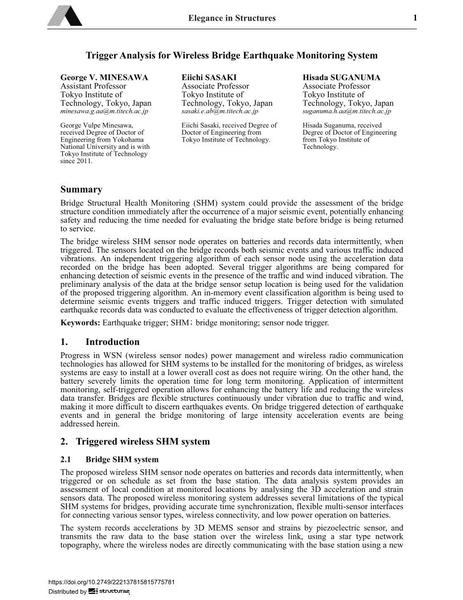Trigger Analysis for Wireless Bridge Earthquake Monitoring System

|
|
|||||||||||
Détails bibliographiques
| Auteur(s): |
George V. Minesawa
Eiichi Sasaki Hisada Suganuma |
||||
|---|---|---|---|---|---|
| Médium: | papier de conférence | ||||
| Langue(s): | anglais | ||||
| Conférence: | IABSE Conference: Elegance in structures, Nara, Japan, 13-15 May 2015 | ||||
| Publié dans: | IABSE Conference Nara 2015 | ||||
|
|||||
| Page(s): | 448-449 | ||||
| Nombre total de pages (du PDF): | 6 | ||||
| Année: | 2015 | ||||
| DOI: | 10.2749/222137815815775781 | ||||
| Abstrait: |
Bridge Structural Health Monitoring (SHM) system could provide the assessment of the bridge structure condition immediately after the occurrence of a major seismic event, potentially enhancing safety and reducing the time needed for evaluating the bridge state before bridge is being returned to service. The bridge wireless SHM sensor node operates on batteries and records data intermittently, when triggered. The sensors located on the bridge records both seismic events and various traffic induced vibrations. An independent triggering algorithm of each sensor node using the acceleration data recorded on the bridge has been adopted. Several trigger algorithms are being compared for enhancing detection of seismic events in the presence of the traffic and wind induced vibration. The preliminary analysis of the data at the bridge sensor setup location is being used for the validation of the proposed triggering algorithm. An in-memory event classification algorithm is being used to determine seismic events triggers and traffic induced triggers. Trigger detection with simulated earthquake records data was conducted to evaluate the effectiveness of trigger detection algorithm. |
||||
